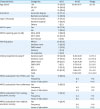Abstract
Purpose
Methods
Results
Conclusion
Figures and Tables
Table 1
Empowering Education Program for MFICU Nurses

Table 2
General Characteristics of Study Subjects (N=49)

Table 3
Comparisons of Confidence and Knowledge Before and After Education Program (N=49)

| Variables | Pretest | Posttest | Difference | t | p |
|---|---|---|---|---|---|
| M±SD | M±SD | M±SD | |||
| Confidence | 97.45±16.13 | 113.59±16.55 | 16.14±21.37 | 5.29 | <.001 |
| Knowledge | 18.10±3.14 | 20.81±2.04 | 2.71±3.53 | 5.37 | <.001 |
Table 4
Differences in Confidence according to Clinical Experience at Delivery Room (N=49)

Table 5
Program Satisfaction Survey at Day 1 and Day 2 (N=46)

Notes
Funding This study was supported by the 2019 Policy Research Fund from Korean Society of Women's Health Nursing.
Author Contributions
Conceptualization: Kim JI, Ahn S, Kim Y.
Formal analysis: Kim JI, Shin, GS, Ahn S.
Investigation: Kim JI, Park M, Shin G, Cho I, Choi SY, Jun EM, Kim Y, Ahn S.
Writing - original draft: Kim JI, Shin G, Ahn S, Park M, Cho I, Choi SY, Jun EM, Kim Y.
Writing - review & editing: Ahn S, Kim JI, Shin G, Kim Y, Cho I, Park M.
Summary Statement
• What is already known about this topic?
With an increase in the number of high-risk pregnancy, the need for the special care of high-risk mothers and fetus/neonates have increased with attention drawn towards a new nursing, the maternal fetal intensive care unit (MFICU) at hospitals.
• What does this paper add?
A 2-day empowering education program for MFICU nurses experienced improvement in the levels of nursing care confidence and knowledge on caring for high-risk mother and fetus/neonates. Satisfaction toward program was high and priority areas for further attention were identified.
• Implications for practice, education and/or policy
This program can serve as a continuous education program for empowering MFICU nurses' clinical nursing knowledge and competency in terms of providing high-quality care for high-risk mothers and their fetus/neonate during the peripartum period.




 PDF
PDF ePub
ePub Citation
Citation Print
Print



 XML Download
XML Download